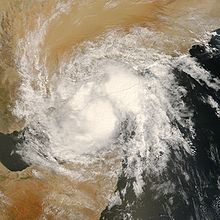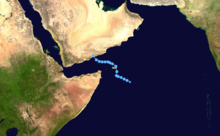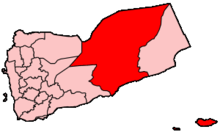- 2008 Yemen cyclone
-
Deep Depression ARB 02 Deep depression (IMD) Tropical Depression (SSHS) 
Deep Depression ARB 02 Formed October 19, 2008 Dissipated October 23, 2008 Highest winds 3-minute sustained:
55 km/h (35 mph)
1-minute sustained:
55 km/h (35 mph)Lowest pressure 988 mbar (hPa; 29.18 inHg) Fatalities 200 Damage $1 billion (2008 USD) Areas affected Yemen, Oman, Somalia Part of the 2008 North Indian Ocean cyclone season Deep Depression ARB 02 (IMD designation: ARB 02, JTWC designation: 03A, also known as the 2008 Yemen cyclone) was the sixth tropical cyclone of the 2008 North Indian Ocean cyclone season, and the second tropical cyclone in the Arabian Sea that year. A weak tropical cyclone, it caused extensive damage in Yemen[1], and minor damage in Oman and Somalia.
Contents
Meterological history
On October 19 the India Meteorological Department noted that an area of low pressure which located to the south east of Salalah, Oman had intensified in to a tropical depression and was assigned the number ARB 02.[2] On October 21 IMD updated the system to a Deep Depression while it lay 700 km south of Salalah, Oman, near the east coast of Somalia.[3] It lost its strength while crossing the Gulf of Aden due to entry of dry air and land interaction as it passed close to the northeastern coast of Somalia. It later was downgraded to a Depression,[4] named TC 03A by the JTWC.[5][6] On October 24 it made landfall on the south-eastern coast of Yemen, and caused severe flooding, leaving about 180 dead.[7] [8][9] The Yemeni governorates of Hadhramaut, Lahij, Al Mahrah and Ta'izz were affected the worst by the floods, and most of the fatalities were in Hadhramaut.[10]
Impact
The flooding was preceded by several days of rain starting on October 23,[11] as the remnants of a tropical cyclone moved over the area. Rain continued, with weather systems coming in from neighbouring Saudi Arabia and southern Somalia, resulting in severe flooding in some areas of Yemen.[12]
Thousands of families fled Hadhramaut alone; many schools were used as evacuee shelters, but these could only accommodate 10% of the affected. According to search and rescue teams, the number of fatalities may increase due to the likelihood of people trapped in flooded houses. Electricity and telephone lines were disrupted, and many homes were damaged.[10]
Survivors were seen signalling to rescue helicopters in Hadramout and Mahra, which had seen at least 30 hours of heavy rain. A Yemeni official was quoted as saying, "About 7,000 people have been made homeless and there are about 100 dead or missing."[13]
Along with fatalities, approximately 730 homes were destroyed, along with businesses and other infrastructure projects. The severe thunder of the preceding thunderstorms resulted in at least nine deaths from lightning in the Al Mahrah, Ta'izz and Lahij governorates.[14] The rain also destroyed large amounts of farmland and killed large numbers of livestock.[12]
Aftermath
The Yemeni government promised to supply tents as a means of emergency shelter, along with other emergency supplies, with six transport aircraft loaded with supplies taking off from Sanaa on Saturday and more scheduled for later. President Ali Abdullah Saleh ordered the creation of a committee to provide aid to affected civilians. Also, the United Arab Emirates declared their intent to provide relief. However, several residents in the city of Shibam say that government assistance and support, if any, is low.[15]
The Organisation of the Islamic Conference declared the situation a "national catastrophe" and started a drive to collect funds for the relief of flood victims.[14]
Yemeni president Ali Abdullah Saleh said, "The damages... are great and the catastrophe is also great."[10]
References
- ^ http://www.unicef.org/infobycountry/yemen_46261.html
- ^ "IMD CWind Advisory 01". IMD. http://www.webcitation.org/5bghxJEdu. Retrieved 2008-10-19.
- ^ "IMD Special Tropical Weather Outlook 21-10-08 06z". IMD. http://www.webcitation.org/5bjKYuKrl. Retrieved 2008-10-21.
- ^ ftp://ftp.met.fsu.edu/pub/weather/tropical/New-Delhi/2008102206.DEMS
- ^ Jim Andrews (2008-10-22). "TC 03A Heads for Yemen". AccuWeather. http://www.accuweather.com/mt-news-blogs.asp?partner=accuweather&blog=Andrews&pgurl=/mtweb/content/Andrews/archives/2008/10/td_03b_heads_for_yemen.asp. Retrieved 2008-10-25.
- ^ Jim Andrews (2008-10-25). "03B Floods Yemen; Bay of Bengal Cyclone Watch". AccuWeather. http://www.accuweather.com/mt-news-blogs.asp?partner=accuweather&traveler=0&blog=Andrews&pgurl=/mtweb/content/Andrews/archives/2008/10/03b_floods_yemen_sends_moisture_north_to_iraq.asp. Retrieved 2008-10-25.
- ^ "Dozens killed by floods in Yemen". WHO. 2008-10-28. http://www.reliefweb.int/rw/rwb.nsf/db900SID/EGUA-7KUL5K?OpenDocument. Retrieved 2008-10-28.
- ^ Lynn, Jonathan (2008-10-28). "About 180 dead or missing after floods in Yemen". Reuters. http://www.reuters.com/article/homepageCrisis/idUSLS392519._CH_.2400.
- ^ http://www.un.org/apps/news/story.asp?NewsID=28736&Cr=Yemen&Cr1=
- ^ a b c d "At least 58 killed in Yemen floods". Xinhua. 2008-10-26. http://news.xinhuanet.com/english/2008-10/26/content_10252296.htm. Retrieved 2008-10-26.
- ^ "Tropical storm lashes Yemen". Herald Sun. 2008-10-26. http://www.news.com.au/heraldsun/story/0,21985,24551718-663,00.html. Retrieved 2008-10-26.[dead link]
- ^ a b "More deaths feared in Yemen floods". Al Jazeera. 2008-10-26. http://english.aljazeera.net/news/middleeast/2008/10/2008102665537762169.html. Retrieved 2008-10-26.
- ^ http://english.aljazeera.net/news/middleeast/2008/10/2008102741743923168.html
- ^ a b "More than 60 killed in fierce Yemen storms". AFP. 2008-10-25. http://afp.google.com/article/ALeqM5hIlZj4QqxC5Ruc0L7BrDmmPkEqFg. Retrieved 2008-10-25.
- ^ "Death Toll Mounts In Yemen Tropical Storm". CBS 13. 2008-10-26. http://cbs13.com/national/Death.Toll.Mounts.2.848789.html. Retrieved 2008-10-26.
Categories:- 2008 in Yemen
- 2008 floods
- 2008 North Indian Ocean cyclone season
- Natural disasters in Yemen
- Deep depressions
Wikimedia Foundation. 2010.


